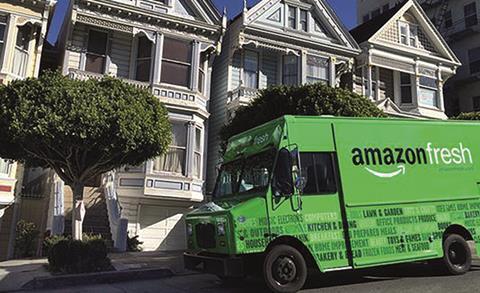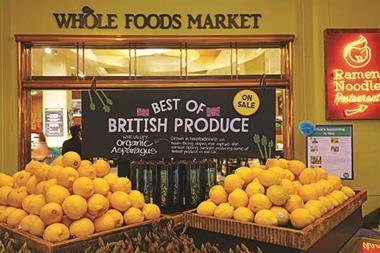Physical stores generally have been given the ultimate vote of confidence from the unlikeliest of sources. Supposed high street tormentor-in-chief Amazon is to fully traverse the divide into store-based retailing through the $13.7bn purchase of Whole Foods.

This marks further blurring of the lines between physical and digital retail and underlines our long-held belief that the future of retailing in neither solely online nor bricks & mortar – it is both. And the end game for all retailers, whatever their roots or origin, is to make the shopping experience as seamless as possible.
Was the Whole Foods deal a surprise? On the one hand, the news was a complete bolt from the blue when it broke on Friday. It had not been widely touted and Amazon’s imperious rise has historically been built upon organic expansion and diversification into new categories, as opposed to large-scale acquisitions.
On the other hand, perhaps we should have been less surprised. If Amazon is serious about being a force in grocery retailing, it was never going to achieve this alone through Amazon Fresh. It was always going to need external partnership in some form – an all-out acquisition of a major store-based player was an option, but more of a long-shot than a likelihood.
Strategic logic
There is considerable strategic logic in the deal. There is substantial customer cross-over between Amazon Prime membership and Whole Foods’ shopper base. The latter has a substantial 400+ store physical footprint across the US, but is largely an online novice.
In contrast, Amazon’s general online know-how and infrastructure are, of course, second to none. But for all their complements, there are still key gaps – neither has significant experience, as yet, of online grocery retailing, which is very different from general merchandise online retailing. Amazon is only feeling its way in certain markets with Amazon Fresh and Whole Foods doesn’t bring any additional expertise in this market. Ocado, on the other hand, most certainly would – watch this space?

This deal is primarily a North American play – this is where Whole Foods has the vast majority of its stores. Online food retailing generally is at a less developed stage Stateside than it is in some parts of Europe and Asia, so it follows that this is where the greatest ‘disruption’ will be felt.
What of the impact in the UK? The level of ‘disruption’ will be far smaller, at least initially, as both Whole Foods and Amazon Fresh are small in scale in the UK. Whole Foods has hardly blazed a trail since it first entered the UK in 2004, often struggling to achieve profitability and expanding to just nine sites. Annual sales are estimated to be £120m - about the same as one of the largest Tesco Extra stores.
Amazon Fresh has an even more limited audience, serving only Amazon Prime members in 300 odd postcode sectors in London and the South East. Estimates of annual sales have recently been put at £25m, which is on a par with a middle-ranking Tesco supermarket in a fairly modest location.
Big Four can’t be complacent
Suggestions that the Amazon and Whole Foods deal will leave the Big Four UK grocery retailers quaking in their boots are desperately wide of the mark. At present, both parties in the UK lack sufficient scale to de-stabilise the existing status quo and Tesco, Asda and Sainsbury’s have far greater experience of grocery multi-channel retailing than their US peers.
Indeed, Amazon and Whole Foods probably have far more to learn from the Big Four than vice-versa. But that said, a joined-up Amazon and Wholefoods in the UK is a platform that will evolve considerably and will not lack cash for further investment. And, lest we forget, Morrisons is also part of the alliance. The other Big Four operators are hardly running scared, but at the same time they will be watching closely and will not be complacent.
Amazon’s Whole Foods deal comes at a time when the narrative around UK foodstores generally is improving. The well-documented structural change is still ongoing, but the major players are slowly but surely restoring their respective houses to order.
Central to this is a recovery in consumer demand. The nadir in the market undoubtedly came in 2015, when foodstore spend actually contracted (-0.1%) for the first time since records began, the result of low volumes and heavy price deflation. Despite ongoing deflation last year, volumes recovered sufficiently to achieve overall market growth of 1.7%.

With very different dynamics, we predict that the UK will report its strongest level of market growth in six years in 2017. On the evidence of the year to date, we forecast that UK foodstore spend will grow in value by more than 4% this year, the highest annual growth since 2011.
Of course, overall market growth is being boosted by a return to inflation on the back of Sterling’s Brexit-induced revaluation, but there is still creditable volume growth as well (2%). In simple terms, prices are going up marginally, but this has yet to deter consumers from spending more in grocery. The market is not without its extreme challenges – not least balancing input cost increases and the extent to which these are absorbed or past onto customers – but a growing market is far more forgiving than a contracting one.
More than anything, the trials and tribulations of the UK grocery market in recent years have served to re-emphasize the importance of foodstore fundamentals – the right store, right-sized, in the right place, sensibly rented and fairly valued. Even in an increasingly multi-channel world, as exemplified by the Amazon and Whole Foods deal, these fundamentals remain central.
After all, Amazon’s purchase of Whole Foods is implicitly also an admission of the difficulties of trading groceries purely online.






























1 Readers' comment